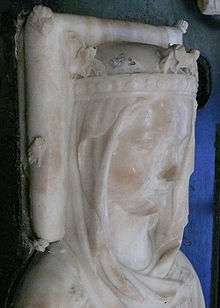Isabella of Aragon, Queen of France
Isabella of Aragon (1248 – 28 January 1271)[1][lower-alpha 1] was Queen of France[3] from 1270 to 1271 by marriage to Philip III of France.[4]
| Isabella of Aragon | |
|---|---|
 | |
| Queen consort of France | |
| Tenure | 25 August 1270 – 28 January 1271 |
| Born | 1248 |
| Died | 28 January 1271 (aged 22–23) |
| Burial | Basilica of St Denis |
| Spouse | Philip III of France |
| Issue | Louis Philip IV of France Robert Charles, Count of Valois |
| House | Barcelona |
| Father | James I of Aragon |
| Mother | Violant of Hungary |
| Religion | Roman Catholicism |
| Wikimedia Commons has media related to Elizabeth of Aragon, Queen of France. |
Life
Isabella was the daughter of King James I of Aragon[5] and his second wife Violant of Hungary.[6]
In Clermont on 28 May 1262, Isabella married the future Philip III of France, son of Louis IX and Margaret of Provence. She became queen upon the accession of her spouse in 1270.
She accompanied her husband on the Eighth Crusade against Tunis. On their way home, they stopped in Cosenza, Calabria. Six months pregnant with her fifth child, on 11 January 1271 she suffered a fall from her horse. After they had resumed the trip back to France, Isabella gave birth to a premature stillborn son. She never recovered from her injuries and the childbirth, and died seventeen days later, on 28 January. Her death was a devastating emotional blow to her husband, especially since she had been pregnant. Philip III took the bodies of Isabella and their stillborn son and, when he finally returned to France, buried them in the Basilica of St Denis.[7] Isabella's tomb, like many others, was desecrated during the French Revolution in 1793.
Children
She had four sons:
- Louis (1265–1276)
- Philip IV "the Fair" (1268–1314), King of France
- Robert (1269–1271)
- Charles, Count of Valois (1270–1325)
Notes
- She had not been born yet when her father King James executed a will in January 1248 since he stipulates that if he had another son, he should become a knight Templar and if the newborn was daughter, she should enter the Monastery of Santa María de Sigena. Isabella was born after January of 1248.[2]
References
- Rodrigo Estevan 2009, p. 90.
- Zurita & 1562-1580, p. 272 of PDF, Chapter XLIII.
- Sabine Geldsetzer, Frauen auf Kreuzzügen
- Patrick Weber, Les reines de France
- The new Cambridge medieval history / 5 C. 1198 - c. 1300. by David Abulafia and Rosamond MacKitterick. The standard work of reference on the whole of Europe, east and west, during the thirteenth century. Page 654.
- The book of deeds of James I of Aragon: a translation of the medieval Catalan Llibre dels Fets by Damian J Smith and Helena Buffery. Page 139.
- Alain Erlande-Brandenburg, Le roi est mort. Étude sur les funérailles, les sépultures et les tombeaux des rois de France jusqu'à la fin du xiiie siècle
Bibliography
- Rodrigo Estevan, María Luz (2009). "Los testamentos de Jaime I: Repartos territoriales y turbulencias políticas". Cuadernos, Centro de Estudios de Monzón y Cinca Media (in Spanish) (35): 61–90. ISSN 1133-3790.
- Zurita, Jerónimo. José Javier Iso; María Isabel Yagüe; Pilar Rivero (eds.). Anales de Aragón (PDF) (in Spanish). Exma. Diputación de Zaragoza, «Institución Fernando el Católico».
| French royalty | ||
|---|---|---|
| Preceded by Margaret of Provence |
Queen consort of France 25 August 1270 – 28 January 1271 |
Succeeded by Marie of Brabant |